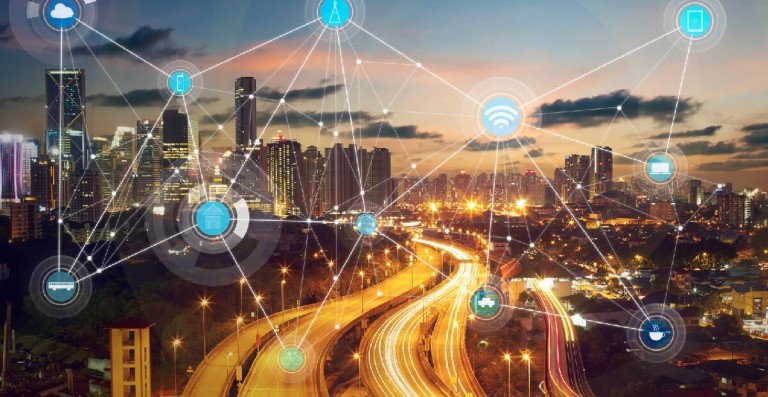
Smart Buildings and the Benefits of Convergence
Working from home, working remotely, hybrid work, and the changing office paradigm are redefining building design and management. Some companies find they don’t need the same space or need to use their space differently. The office isn’t going away, but it’s definitely changing, and smart buildings are crucial to those changes.
Along with changes in how we use real estate, our buildings are being called on to do more for us. Flexibility for tenants, comfort for employees, protection of assets, and safety for everyone are front and center in new construction. The fact that you can provide all those things -and more- and save 30% on operating costs makes investing in smart buildings an attractive option. The ancillary benefits are tenant satisfaction, employee retention, increased building lifespan, and maximizing use and occupancy. Add in the fact that smart buildings are necessary for reducing or eliminating greenhouse emissions, and the case for smart buildings is even more solid.
The Name of the Game: Convergence
If IT and OT had a child, it would be called IoT. The Internet of Things brings unprecedented abilities to both Information Technology and Operational Technology, and the line between them is blurring. According to Gartner, “By 2025, 75% of OT security solutions will be delivered via multifunction platforms interoperable with IT security solutions.”(1) The convergence of IT and OT onto a single IP network isn’t limited to security; it drives a further convergence of Facilities Management and Property Management. According to Gartner, IoT expenditures in smart buildings were $53 Billion in 2020 and are expected to reach $108 Billion by 2030.(2)
With a centralized Business Management System in a smart building running on a converged IP network, ceiling light fixtures are IoT products. A failed light panel doesn’t have to be reported to OT or a Facilities Manager. Instead, if the panel experiences a problem, it can report directly to the BMS. If the panel fails altogether, SNMP monitoring by the IT department will flag the loss of communication and notify the appropriate personnel to investigate. Such reporting can extend right back to a vendor for products under onsite repair/replace warranties. These instant notifications reduce downtime and the financial impact that usually follows.
It’s serendipitous that OT is beginning to rely on equipment that relies on IT. Operational Techs are familiar with keeping equipment running but perhaps less familiar with cyber security threats. Now their equipment is being more exposed to bad actors on the Internet - the same threats that IT is expert at keeping out of their network. Convergence allows resources to be better used and delivers a single IP network that is well protected and is accessible to all building and business systems.
The Driving Forces
In an enormous meta-analysis, university researchers from Brazil and Australia identified the top eleven drivers in the smart building market. They organized these drivers by the primary beneficiaries for each, the owner, users, and the environment. The beneficiaries are listed within the scope of Management -not Facilities Management or Property Management, but Management, since the two are less distinct every day. (3)
Technology and Integration
Technology advances in the last decade have revolutionized the analog and digital interface between computers and the outside world. Miniaturization has brought us inertial navigation systems, weight scales, environmental chemical sensors, light, humidity, sound sensors and hundreds of related devices. Most are inexpensive and can be incorporated into any situation. These devices connect wirelessly to the BMS network, and many can be configured to act as relays for other sensors that would otherwise be out of range of the network.
Sound sensors can be used in open office settings to monitor loud noises that disrupt users in the space. Moisture sensors can keep equipment dry and planters watered. Light sensors placed next to artwork can tell blinds to close when sunlight hits the sensitive painting. Sensors are fully integrated into many light fixtures, allowing the light temperature to change according to user preferences or ambient light coming in on overcast days. Light fixtures can also steer users along emergency evacuation routes or lead visitors to the department they need. In light panels with dozens (or hundreds) of LEDs, monitoring power consumption can tell the unit if one or more LEDs has failed, which often signals an impending problem. That information can be relayed to the BMS and the fixture replaced before anyone notices an issue.
Flexibility
relocates in a smart building, the system moves her phone extension to the new location; the computer in the new location will automatically print to the nearest printer, and all of her files and preferences will follow her there. The elevators will even take her to the correct floor, and the HVAC will know how she likes the thermostat set. These features make it easy to create teams for special projects and locate them together where they can collaborate or access special equipment, all while reducing the workload for managers.
Flexibility takes on new scales in today’s modern buildings. For example, if a tenant decides they need more or less space or needs to rearrange the physical office layout, walls can be moved, and smart light switches can control specific light fixtures in the newly formed offices. This flexibility allows for corporate growth without sacrificing lighting and energy efficiency to the restrictions posed by a static building layout.
Health, Comfort, and Satisfaction
Along with users’ comfort, smart buildings can monitor various health influences. Air quality monitoring can check for mold, pollen, dust, CO2, Carbon Monoxide, Ozone, and noxious chemicals used in cleaning and refrigeration, like chlorine and ammonia. Ionizing radiation sensors can be located where radioactive materials are used or stored and sound alarms if a leak is detected. Refrigerators can be monitored and logged every 15 minutes, as many medical lab protocols require. The water feature in the lobby can monitor the water clarity, temperature, pH, nitrites, and ammonia and notify the contractor if something goes out of range. Instead of weekly visits, they come when they’re needed. Research has shown that “in the US alone, the savings and productivity gains from improved indoor environments are between $25 billion to $150 billion a year.”(4)
Providing a flexible and comfortable work environment tailored to the users, accompanied by the security of knowing the environment is being monitored for hazards, increases user satisfaction. In addition, a healthier workspace increases retention and lowers the costs associated with employee turnover.
Security
The security features of smart buildings are the oldest and best-known features, but today, security means something quite a bit more. Placing hundreds (if not thousands) of devices in a smart building on a network exposes them to attack. Hackers look for weaknesses in IoT devices to manipulate them into whatever network access they can manage. In addition, devices come with their own software components, which can contain security holes. IT can secure many flaws by ensuring the devices are set up properly on their network, with passwords, encryption and changes locked down. They can further limit the exposure by properly segmenting their network utilizing edge computing and route summarization.
While centralized monitoring and control rely on having all of the elements on a common network, that doesn’t mean all devices are accessible to each other. Segmenting the network allows IT to group related devices in logical groups. For example, the BMS application can access some groups, and the business applications can access others, but groups cannot directly access members in other groups. This method allows groups based on physical location, device type, or other criteria dictated by security concerns. Segmentation allows IT to dictate security specifics based on the threats faced by the members of each group. It also means that any bad actor who gains access to a device can only access other group members, greatly limiting their potential impact.
Another feature unique to network security is Allied Telesis' AMF-Sec. This network security system watches for unusual activity: repeated failed user logins, user logins at unusual terminals or devices, unusual user movements, data leaks, and unusual network activity. AMF-Sec can isolate the resources in real-time, giving IT or management time to investigate and remediate.
Longevity
Longevity is the measure of tenants staying in a building. Catering to personal preferences, providing unprecedented flexibility for operational changes, protecting individual health, and providing workplace security are all features that keep tenants in a building longer. Longevity has become imperative in the wake of the pandemic. According to research by MIT, healthy buildings in the US rent for as much as 7.7% higher per square foot than buildings that do not meet WELL or FITWELL certifications.
Finding Direction
Many building certification systems have become relevant in recent years. BREEAM and LEED have been around for several years, though geared specifically to build energy efficiency. The Telecommunications Industry Association (TIA) and UL announced the creation of SPIRE in 2020 as the “world’s first comprehensive, objective assessment and rating program for smart buildings.”(5) In February 2022, The Carbon Trust announced the Route to Net Zero Standard.(6) Both SPIRE and RNZ work with developers to plan and implement smart building technologies, carbon-neutral materials, and an overall plan for building impact with a goal of zero emissions over the life of the building.
One idea that has become far more common in the last few years is the role of existing buildings as we advance. According to the Carbon Trust, “As new stock will be insufficient, retrofitting existing stock, whenever possible, will be essential to meet market demand for net-zero carbon space. Re-use is the responsible course of action when considering the embodied carbon implications of new construction.”(6) While it may not be intuitive to make a large investment into an existing property, smart building renovations increase return on investment. Payback can take less than two years and provide 25% energy savings annually.(7) According to JLL, energy-efficient buildings sell for 17% more than their counterparts, generate 35% more rental income, and have 18% higher occupancy rates.(8)
Carbon in the Cloud
As a quick case study, Datacenters are, by definition, smart buildings. The critical nature of their operation and the sensitive equipment they house makes responsive climate management, intense security, and access control central to their function.
Leading providers of cloud infrastructure and platform services are increasingly focusing on how they can disrupt higher-level business, compliance, societal and environmental issues. Hyperscalers are aggressively investing in sustainable cloud operations and delivery, aspiring to eventually achieve net zero emissions within the decade, or sooner. (10)
Distinguished Research Vice President at Gartner,
From 2010 to 2018, global IP traffic increased tenfold. Over that same period, cloud storage grew by a factor of 25. While hard to pin down, estimated power consumption by Datacenters is something between 1-2% of global power consumption. Their staggering growth is tempered largely by improved energy efficiencies in the server and storage hardware in the centers themselves.(9) Their mission also hinges on having ample access to uninterruptable power, which means many are located near renewable energy installations and include huge battery banks for emergencies. Therefore, Datacenters are uniquely positioned to make significant efficiency gains and reduce their emissions to zero.
Datacenter clients are calling for more information on sustainability as part of their efforts to reduce their environmental impact. This is putting pressure on data centers to reduce their carbon footprint and to be able to report on those outcomes transparently. Gartner predicts that by 2025, sustainability will be a Top 3 criteria for cloud customers.(10)
Room for Growth
Lastly, it’s vital to remember that every user benefit, tenant perk and owner advantage for a smart building scales up beautifully. The Building Management Software can easily become the Campus Management or Enterprise Management Software. By incorporating encrypted data tunnels and redundant links, the same management systems can configure and control buildings across the quad, town, or the continent. The IT Department can deploy the necessary physical equipment at any location to tie back to the central monitoring. If users move to a new location, their preferred settings and personal information follow them. The benefits multiply with more locations.
Smarter networks underpin smarter buildings
All of these intelligent services that enable smart buildings – like layout and user flexibility, access control, heating and lighting, security, and more – need 24/7 connectivity to the BMS to ensure operational efficiency that maximizes building ROI and provides the best possible user experience.
A converged data network that delivers a wealth of information reliably from the many end devices and systems to the BMS is essential for optimal building performance. Allied Telesis provides resilient, always-on networks that underpin smart building operations.
Our resilient wired switching technologies like Virtual Chassis Stacking and High-speed, resilient rings provide networks with no single-point-of-failure and self-healing operation. At the same time, our self-tuning hybrid wireless solutions enable maximum Wi-Fi performance for seamless IoT device and user connectivity. Add in superior network automation partnered with visual monitoring and management of the entire network, and you have assured smart building operation running on a smarter network.
Allied Telesis partners with leaders in cybersecurity, access control, and building management to bring our customers cohesive turn-key solutions for Smart Buildings.
Build Smarter with Allied Telesis.
References
(1) V. P. C. Thielemann, "Market Guide for Operational Technology Security," 13 January 2021. [Online]. Available: https://www.gartner.com/doc/reprints?id=1-27KE4QKL&ct=210930&st=sb.
(2) X. F. Sharpington, "Forecast Analysis: Smart Buildings IoT Endpoint Electronics and Communications Revenue, Worldwide," 26 July 2021. [Online]. Available: https://www.gartner.com/en/documents/4004043.
(3) e. a. Monteiro Froufe, "Smart Buildings: Systems and Drivers," 2 September 2020. [Online]. Available: https://www.mdpi.com/2075-5309/10/9/153/pdf.
(4) JLL, "Three new factors influencing the value of buildings," 19 January 2022. [Online]. Available: https://www.us.jll.com/en/trends-and-insights/cities/three-new-factors-influencing-the-value-of-buildings.
(5) Soncodi, "Measuring the Impact of Smart Building Technology Investments," 2021. [Online]. Available: https://www.naiop.org/en/Research-and-Publications/Magazine/2021/Spring-2021/Business-Trends/Measuring-the-Impact-of-Smart-Building-Technology-Investments.
(6) "The Carbon Trust launches new Route to Net Zero Standard, certifying the journey to climate leadership," 21 February 2022. [Online]. Available: https://www.carbontrust.com/news-and-events/news/the-carbon-trust-launches-new-route-to-net-zero-standard-certifying-the.
(7) E. A. H. Perry, "Smart buildings cut emissions," 24 March 2020. [Online]. Available: https://www.hsbc.com/insight/topics/smart-buildings-cut-emissions.
(8) Schnieder Electric, "How unlocking the potential of a smart building can reduce cost and boost business," 7 February 2018. [Online]. Available: https://www.cnbc.com/advertorial/2018/02/07/how-unlocking-the-potential-of-a-smart-building-can-reduce-cost-and-boost-business.html.
(9) M. e. al., "HOW MUCH ENERGY DO DATA CENTERS REALLY USE?," March 2020. [Online]. Available: https://www.agci.org/solutions/quarterly-research/2020-03-DataCenters.
(10) Gartner, "Gartner Predicts Hyperscalers’ Carbon Emissions Will Drive Cloud Purchase Decisions by 2025," 24 January 2022. [Online]. Available: https://www.gartner.com/en/newsroom/press-releases/2022-01-24-gartner-predicts-hyperscalers-carbon-emissions-will-drive-cloud-purchase-decsions-by-2025.
(11) Gartner, "Gartner Says Three Emerging Environmental Sustainability Technologies Will See Early Mainstream Adoption by 2025," 21 April 2022. [Online]. Available: https://www.gartner.com/en/newsroom/press-releases/2022-04-21-gartner-says-three-emerging-environmental-sustainability-technologies-will-see-early-mainstream-adoption-by-2025.


